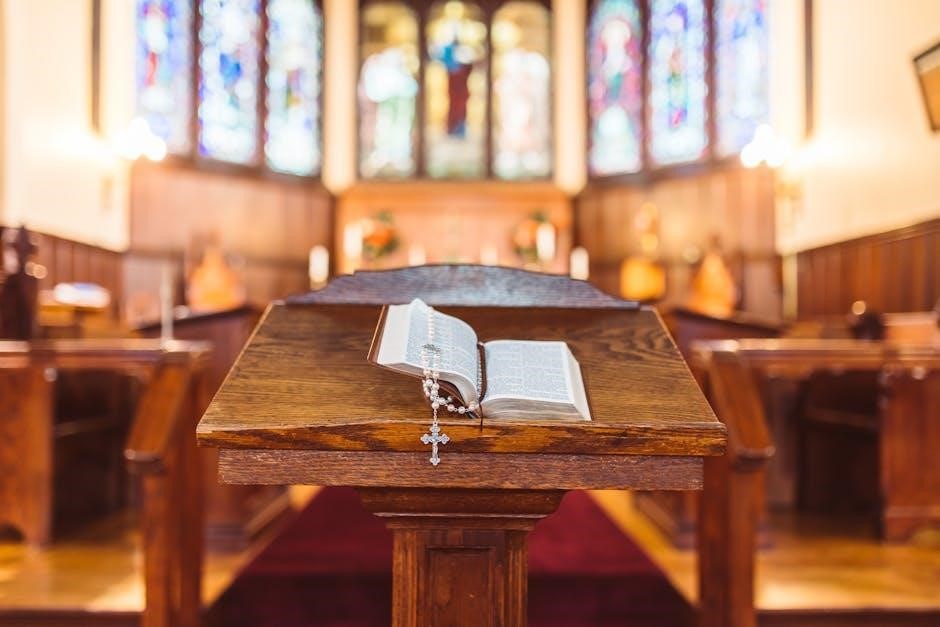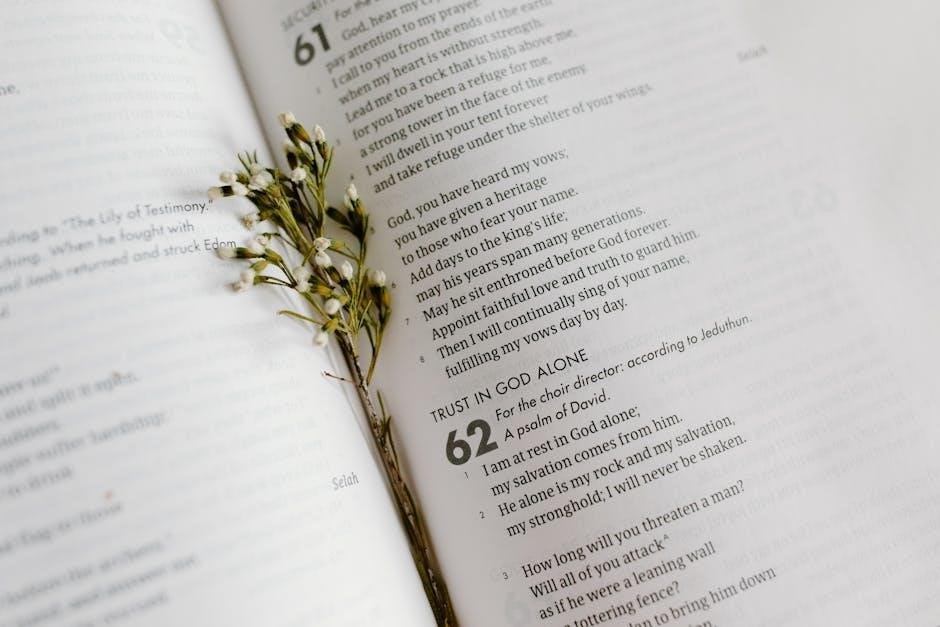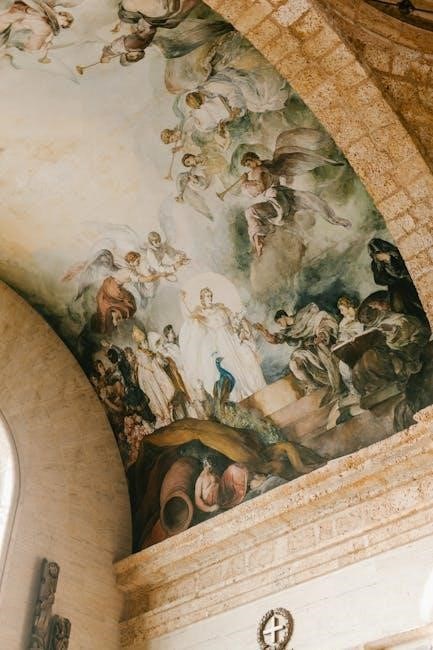freemason holy bible pdf
Freemasonry deeply integrates the Holy Bible as a foundational text, often placing it centrally on the Masonic altar․ This symbolizes its role in guiding moral and spiritual principles․
The Role of the Holy Bible in Freemasonry
The Holy Bible holds a central and revered position in Freemasonry, often referred to as the “Great Light” of the fraternity․ It is placed prominently on the Masonic altar during rituals and ceremonies, symbolizing its importance as a moral and spiritual guide․ Freemasonry does not dictate religious beliefs but encourages members to adhere to the principles of their faith, with the Bible serving as a unifying text for many․ Its teachings are used to impart wisdom, ethical conduct, and brotherly love, forming the foundation of Masonic philosophy․ The Bible’s inclusion in Masonic practices underscores its role in fostering a sense of unity and shared values among members, regardless of their specific religious affiliations․
Historical Connection Between Freemasonry and the Bible
Freemasonry’s historical connection to the Bible is deeply rooted in its origins, which trace back to medieval stonemasons and their guilds․ These early masons were influenced by biblical narratives, particularly the construction of King Solomon’s Temple, a central symbol in Masonic lore․ The Bible’s account of skilled craftsmen building a sacred structure resonated with masons, who saw parallels in their own craftsmanship and moral aspirations․ Over time, Freemasonry adopted biblical stories and teachings as allegorical frameworks for its rituals and ethical lessons․ This historical bond is reflected in the prominence of the Bible in Masonic ceremonies and its use as a moral guide, emphasizing principles such as truth, justice, and brotherly love․ The fraternity’s connection to the Bible underscores its commitment to timeless virtues and spiritual enlightenment․

The Significance of the Masonic Altar and the Holy Bible
The Masonic altar holds profound significance as the sacred center of lodge ceremonies, symbolizing the union of faith and brotherhood․ Atop this altar rests the Holy Bible, often alongside other sacred texts, representing divine guidance and moral truth․ The Bible’s placement signifies its role as the primary source of ethical and spiritual instruction in Freemasonry․ During rituals, candidates swear oaths on the Bible, emphasizing their commitment to truth and integrity․ The altar itself embodies the fraternity’s dedication to harmony and unity, as it serves as a focal point for reflection and shared values․ This sacred setup underscores Freemasonry’s reverence for the Holy Bible as a cornerstone of its teachings and practices, fostering a deeper connection among members and their spiritual journey․

The Holy Bible in Masonic Rituals and Teachings
The Holy Bible holds prominence in Masonic rituals, serving as a moral guide and symbol of divine truth․ Its teachings inspire brotherly love, ethical conduct, and spiritual growth․
The Use of the Holy Bible in Masonic Ceremonies
The Holy Bible plays a central role in Masonic ceremonies, often placed prominently on the altar as a symbol of divine truth and moral guidance․ During rituals, the Bible is frequently referenced to emphasize principles such as honesty, compassion, and justice․ Many ceremonies incorporate readings from the Bible to convey spiritual lessons and reinforce ethical behavior․ For instance, in initiation rites, candidates may take oaths with a hand placed on the Bible, signifying their commitment to upholding its teachings․ The Bible’s presence serves to unite participants in shared values, fostering a sense of brotherhood and mutual respect․ Its use in Masonic ceremonies underscores the importance of faith and morality in the pursuit of personal and collective enlightenment․
Biblical Symbolism in Freemasonry
Biblical symbolism is deeply woven into Freemasonry, with numerous references drawn from the Holy Bible to convey moral and spiritual truths․ The Temple of Solomon, for example, is a central symbol, representing wisdom and divine architecture․ Tools like the square and compasses are often linked to biblical narratives, such as the construction of the Temple, where they symbolize order and precision; The All-Seeing Eye, another prominent symbol, is interpreted as a representation of divine providence, akin to biblical descriptions of an omniscient God․ Additionally, the story of Hiram Abiff, a skilled craftsman in the Temple’s construction, is used to illustrate themes of loyalty, sacrifice, and the pursuit of knowledge․ These symbols serve to enrich Masonic teachings, offering members a profound connection to biblical heritage and timeless moral lessons․
The Influence of Biblical Teachings on Masonic Principles
Biblical teachings profoundly shape Freemasonry’s core principles, emphasizing brotherly love, relief, and truth․ The Holy Bible is often viewed as a moral guide, influencing Masonic values such as justice, mercy, and humility․ Biblical narratives, like the story of the Temple of Solomon, underscore themes of wisdom, divine order, and the importance of communal effort․ Masonic rituals and ceremonies frequently incorporate biblical references to illustrate ethical lessons, encouraging members to lead virtuous lives․ The principles of faith, hope, and charity, central to Freemasonry, align closely with biblical teachings, fostering a sense of unity and shared purpose among members․ This integration of biblical wisdom ensures that Freemasonry remains a fraternity deeply rooted in spiritual and moral growth, guiding individuals toward self-improvement and service to others․

Freemasonry and Biblical Foundations
Freemasonry traces its origins to biblical accounts, particularly King Solomon’s Temple, symbolizing wisdom and divine order․ Biblical narratives form the cornerstone of Masonic history and philosophical teachings, emphasizing spiritual growth․
The Biblical Account of Masonic Origins
Freemasonry traces its origins to the construction of King Solomon’s Temple, as described in the Bible․ The story of the temple’s building, involving skilled craftsmen and divine wisdom, is central to Masonic lore․ Biblically, Solomon’s Temple represents a pinnacle of spiritual and architectural achievement, symbolizing the pursuit of knowledge and unity․ Masonic traditions draw parallels between the temple’s construction and the development of moral and ethical principles․ The biblical account of Hiram Abiff, the master builder, is particularly significant, as it embodies themes of sacrifice, integrity, and the quest for perfection․ These narratives form the bedrock of Masonic teachings, emphasizing the importance of faith, brotherhood, and the pursuit of wisdom․
The Role of King Solomon in Masonic History
King Solomon holds a revered position in Masonic history, particularly due to his association with the construction of the Temple in Jerusalem․ The biblical account of Solomon’s wisdom and his role as a leader and builder is deeply symbolic in Freemasonry․ His ability to unite diverse skills and knowledge under a common purpose mirrors Masonic ideals of brotherhood and collaboration․ The temple’s construction, under Solomon’s reign, is seen as a metaphor for the pursuit of spiritual and moral enlightenment․ Masonic rituals and teachings often draw inspiration from Solomon’s reign, emphasizing wisdom, justice, and the harmonious blending of art and science․ His legacy serves as a cornerstone for Masonic philosophy, illustrating the transformative power of leadership and the pursuit of divine truth․
The Connection Between the Temple of Solomon and Freemasonry
The Temple of Solomon is a central symbol in Freemasonry, representing the pinnacle of divine architecture and wisdom․ In Masonic teachings, the temple is seen as a microcosm of the universe, with its construction symbolizing the quest for perfection and harmony․ Masonic rituals often draw parallels between the temple’s building and the development of the individual, emphasizing themes of spiritual growth and moral refinement․ The temple’s destruction and rebuilding are also interpreted as metaphors for personal and communal renewal․ Freemasonry’s use of architectural symbolism, such as the square and compasses, reflects the influence of the temple’s design and purpose․ This connection underscores Freemasonry’s commitment to preserving ancient wisdom and applying it to contemporary ethical and philosophical questions․

The Freemason Holy Bible PDF
The Freemason Holy Bible PDF is a digital version of the Bible used in Masonic rituals, emphasizing biblical teachings and their alignment with Masonic principles of morality and wisdom․
What is the Freemason Holy Bible PDF?
The Freemason Holy Bible PDF is a digital version of the Holy Bible specifically used within Freemasonry, often referenced in Masonic rituals and teachings․ It emphasizes biblical narratives and moral lessons that align with Masonic principles such as truth, justice, and brotherly love․ The PDF format makes it easily accessible for modern Masons, allowing them to study and reflect on its teachings in a convenient way․ While the content remains identical to the standard Holy Bible, its context within Freemasonry highlights its symbolic and philosophical significance․ This version is particularly valued for its role in guiding Masonic education and spiritual growth․

It serves as a foundational resource for understanding the biblical roots of Freemasonry, making it a vital tool for both new and experienced members․ Its digital form ensures its teachings remain relevant in contemporary times․
Differences Between the Freemason Bible and the Standard Bible
The Freemason Bible and the standard Bible share the same foundational religious texts, but the Freemason version often includes additional annotations and commentary that align with Masonic principles․ While the core content remains unchanged, the Freemason Bible may emphasize certain verses or themes that resonate with Masonic values such as brotherly love, truth, and moral integrity․ It might also include historical context or references significant to Freemasonry’s origins and rituals, offering a unique perspective for Masonic study and reflection․
Additionally, the Freemason Bible might feature introductory sections or appendices that explore the role of the Bible in Masonic traditions, enhancing its relevance within the fraternity․ Despite these enhancements, the translation and structure of the biblical text itself typically remain consistent with standard versions, ensuring its accessibility and familiarity for Masons․
The Purpose of the Freemason Holy Bible PDF
The Freemason Holy Bible PDF serves as a vital resource for Masonic study and reflection, blending biblical teachings with Masonic principles․ Its purpose is to provide a deeper understanding of the interconnections between Freemasonry and the Holy Bible, offering insights into moral and ethical guidance․ The PDF format ensures accessibility, allowing Masons to easily reference and study the text digitally․ It is often used in Masonic rituals and ceremonies, serving as a foundational document for spiritual and philosophical growth․ Additionally, it acts as a preservation of Masonic traditions, making it an essential tool for both new and experienced members of the fraternity․ The Freemason Holy Bible PDF is not merely a religious text but a comprehensive guide for fostering enlightenment and unity among Masons worldwide․

Symbolism and Interpretation
Freemasonry richly employs biblical symbolism, interpreting texts through moral and spiritual lenses․ The All-Seeing Eye and Square and Compasses reflect divine wisdom and justice, guiding Masonic principles and ethical conduct․
Masonic Symbols and Their Biblical Roots
Masonic symbols are deeply rooted in biblical narratives and imagery․ The All-Seeing Eye, often depicted in Freemasonry, symbolizes divine providence and omniscience, reflecting biblical descriptions of God’s watchful presence․ The Square and Compasses, central to Masonic iconography, represent moral rectitude and boundaries, aligning with biblical teachings on justice and righteousness․ Additionally, the Masonic ladder, a symbol of spiritual ascent, draws parallels to Jacob’s ladder in Genesis, signifying a connection between earth and heaven․ These symbols serve as visual reminders of moral and spiritual truths, bridging the gap between biblical wisdom and Masonic principles․ By incorporating these motifs, Freemasonry emphasizes the timeless relevance of biblical teachings in guiding personal and communal conduct․
The All-Seeing Eye and Its Biblical Significance
The All-Seeing Eye is a prominent Masonic symbol, often depicted as an eye surrounded by rays of light, symbolizing divine omniscience and providence․ This imagery draws heavily from biblical descriptions of God’s all-seeing nature, such as in Proverbs 15:3, which states, “The eyes of the Lord are in every place, beholding the evil and the good․” In Freemasonry, the All-Seeing Eye serves as a reminder of moral accountability and the idea that one’s actions are always under divine scrutiny․ It is often associated with the Great Architect of the Universe, a concept central to Masonic philosophy․ The symbol also appears in the context of biblical narratives, such as the divine presence watching over Israel, reinforcing its connection to sacred texts․ This emblem underscores the moral and spiritual principles that Freemasonry seeks to uphold, aligning with biblical teachings on justice, wisdom, and divine guidance․
The Square and Compasses as Biblical Metaphors
The Square and Compasses are the most recognizable symbols of Freemasonry, often depicted together on Masonic regalia and literature․ The Square represents morality and the regulation of actions, while the Compasses signify ethical boundaries and the quest for self-improvement․ Biblically, these tools find metaphorical resonance in Proverbs 11:1, which mentions the “just weight and balance,” symbolizing fairness and integrity․ Additionally, the Compasses can be linked to the biblical concept of self-discipline, as taught in Galatians 5:22-23, emphasizing the importance of moral boundaries․ Together, these symbols reflect the dual focus of Freemasonry on earthly actions and spiritual aspirations․ Their prominence in Masonic rituals and teachings underscores their alignment with biblical principles of justice, moderation, and the pursuit of moral perfection․ This duality makes them powerful metaphors for living a virtuous life, as guided by both Masonic and biblical ideals․

Historical Figures and Their Contributions
Historical figures like A․E․ Waite significantly contributed to Masonic biblical studies, bridging Kabbalah and Freemasonry․ Their interpretations enriched Masonic traditions and deepened the understanding of the Freemason Holy Bible PDF․
Prominent Freemasons and Their Biblical Interpretations
Prominent Freemasons like A․E․ Waite have significantly influenced Masonic biblical studies․ Waite, a renowned scholar and Freemason, explored the connections between Kabbalah and Freemasonry, offering deep insights into biblical symbolism․ His work emphasized the spiritual dimensions of Masonic teachings, aligning them with biblical principles․ Other notable Freemasons have contributed to interpreting the Holy Bible through a Masonic lens, blending historical and esoteric perspectives․ Their interpretations often highlight the allegorical and moral lessons within scripture, enriching Masonic traditions․ These contributions have provided a framework for understanding the Freemason Holy Bible PDF as a tool for spiritual growth and enlightenment․ Their work continues to inspire contemporary Masons, fostering a deeper appreciation for the interplay between Freemasonry and biblical teachings․
The Influence of A․E․ Waite on Masonic Biblical Studies
A․E․ Waite, a prominent Freemason and scholar, profoundly influenced Masonic biblical studies by integrating esoteric traditions with biblical interpretation․ His work highlighted the symbolic connections between Freemasonry and the Holy Bible, particularly through Kabbalah․ Waite’s writings, such as his books on the Holy Grail and mystical symbolism, bridged Freemasonry with esoteric Christianity․ He emphasized the spiritual dimensions of Masonic rituals, drawing parallels to biblical narratives․ Waite’s interpretations of the Freemason Holy Bible PDF focused on allegorical meanings, offering deeper insights into Masonic teachings․ His work remains a cornerstone of Masonic biblical studies, inspiring modern interpretations and fostering a richer understanding of the interplay between Freemasonry and the Holy Bible․
The Role of Kabbalah in Freemasonry and the Bible
Kabbalah, a Jewish mystical tradition, has influenced Freemasonry by offering esoteric interpretations of biblical texts․ Freemasons often incorporate Kabbalistic symbolism to deepen their understanding of the Holy Bible․ This integration allows for a more profound exploration of biblical narratives, aligning with Freemasonry’s emphasis on moral and spiritual growth․ The Freemason Holy Bible PDF sometimes includes Kabbalistic interpretations, providing members with a richer framework for studying sacred texts․ By blending Kabbalah with Masonic principles, Freemasonry fosters a unique approach to biblical study, emphasizing hidden meanings and symbolic connections․ This synthesis enhances the spiritual dimensions of Masonic rituals and teachings, making the Holy Bible a central tool for both moral guidance and esoteric exploration․

Contemporary Perspectives
Modern interpretations of the Freemason Holy Bible PDF emphasize its relevance in the digital age, blending traditional teachings with contemporary spiritual practices and technological accessibility․
Modern Interpretations of the Freemason Holy Bible PDF
Modern interpretations of the Freemason Holy Bible PDF emphasize its enduring relevance in contemporary spirituality․ Many contemporary Masons view the PDF as a bridge between ancient teachings and digital accessibility, allowing for deeper exploration of biblical symbolism and moral guidance․ Themes such as brotherly love, truth, and relief are reinterpreted in today’s context, resonating with a diverse, global membership․ The PDF format has also enabled wider dissemination, making the text accessible to those who might not have had access to physical copies․ This modern approach highlights the adaptability of Freemasonry, blending tradition with innovation to remain a vital force in spiritual and philosophical discourse․ The Freemason Holy Bible PDF continues to inspire personal growth and communal reflection, ensuring its legacy endures in the digital age․
The Relevance of Freemasonry in the Digital Age
Freemasonry’s relevance in the digital age is evident through its adaptability to modern technological advancements․ The Freemason Holy Bible PDF exemplifies this shift, making ancient teachings accessible to a global audience․ Digital platforms have enabled the fraternity to reach younger generations, fostering engagement and curiosity about Masonic principles․ The PDF format allows for easy sharing and study, ensuring that the Holy Bible’s role in Freemasonry remains central․ Modern interpretations emphasize the timeless wisdom of the text, aligning it with contemporary values of diversity and inclusivity․ By embracing digital tools, Freemasonry continues to inspire personal growth and community building, proving its enduring relevance in a rapidly changing world․ This blend of tradition and innovation ensures that Freemasonry remains a vibrant and influential force in the 21st century․
The Impact of Freemasonry on Contemporary Spirituality
Freemasonry significantly influences contemporary spirituality by offering a framework for personal growth and ethical living․ The Freemason Holy Bible PDF serves as a digital resource, making timeless biblical teachings accessible to modern seekers․ It bridges tradition and innovation, appealing to those exploring spirituality in a tech-driven world․ Freemasonry’s emphasis on universal values like brotherly love and truth resonates with individuals seeking meaning beyond materialism․ The fraternity’s rituals and symbols, deeply rooted in biblical narratives, provide a spiritual anchor in an ever-changing society․ By fostering introspection and community, Freemasonry continues to inspire individuals to align their lives with higher moral and spiritual principles, ensuring its relevance in shaping contemporary spiritual journeys․
The Freemason Holy Bible PDF remains a timeless resource, blending tradition with modern accessibility․ Its enduring influence underscores the Bible’s central role in Freemasonry, guiding spiritual growth and ethical standards․
The Enduring Legacy of the Freemason Holy Bible PDF
The Freemason Holy Bible PDF stands as a testament to the enduring connection between Freemasonry and biblical traditions․ Its digital format ensures accessibility, preserving ancient wisdom for modern seekers․ By integrating biblical teachings with Masonic principles, it serves as a moral and spiritual guide․ The PDF highlights the Bible’s central role in Masonic rituals, symbolism, and philosophy; It bridges the past and present, offering insights into the historical roots of Freemasonry․ The document underscores the Bible’s significance in fostering unity and ethical living among Freemasons․ Its legacy lies in its ability to inspire reflection and growth, making it a vital resource for both new and seasoned members of the fraternity․ This digital version ensures that the timeless lessons of the Holy Bible remain relevant in an ever-evolving world․
The Future of Freemasonry and the Holy Bible
The future of Freemasonry and the Holy Bible remains deeply intertwined, with the Freemason Holy Bible PDF playing a pivotal role in preserving and sharing these traditions․ As technology advances, the PDF format ensures that the teachings of the Holy Bible and their Masonic interpretations remain accessible to a global audience; This digital resource will continue to serve as a bridge between ancient wisdom and modern spirituality․ By adapting to the digital age, Freemasonry can attract new members while maintaining its core values․ The Holy Bible’s timeless lessons will inspire future generations to embrace moral and ethical living․ The Freemason Holy Bible PDF will remain a cornerstone of Masonic education, fostering spiritual growth and unity within the fraternity․ Its enduring relevance will ensure that the principles of Freemasonry thrive in an ever-evolving world․

Final Thoughts on the Freemason Holy Bible PDF
The Freemason Holy Bible PDF stands as a timeless resource, blending biblical teachings with Masonic principles to guide spiritual and moral growth․ It serves as a bridge between ancient wisdom and modern understanding, offering insights into the fraternity’s values․ By digitizing these teachings, the PDF ensures accessibility for future generations, preserving the legacy of Freemasonry․ Its significance lies in its ability to unite members worldwide under shared principles of truth, justice, and brotherhood․ As a comprehensive guide, it fosters deeper understanding of both the Bible and Freemasonry, reinforcing their interconnectedness․ The Freemason Holy Bible PDF is not just a text but a living document that continues to inspire and educate those seeking enlightenment and fellowship․

